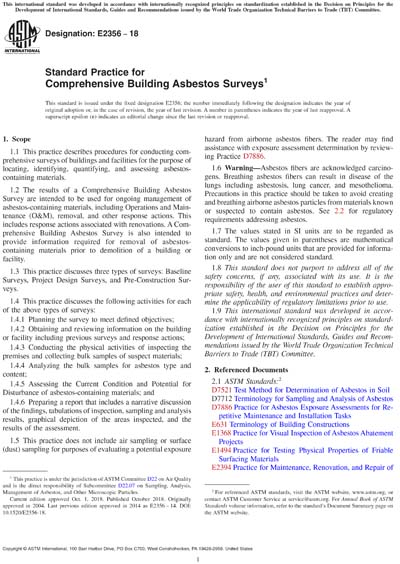Most recent
ASTM E2356-18
Standard Practice for Comprehensive Building Asbestos Surveys
1.1 This practice describes procedures for conducting comprehensive surveys of buildings and facilities for the purpose of locating, identifying, quantifying, and assessing asbestos-containing materials.
1.2 The results of a Comprehensive Building Asbestos Survey are intended to be used for ongoing management of asbestos-containing materials, including Operations and Maintenance (O&M), removal, and other response actions. This includes response actions associated with renovations. A Comprehensive Building Asbestos Survey is also intended to provide information required for removal of asbestos-containing materials prior to demolition of a building or facility.
1.3 This practice discusses three types of surveys: Baseline Surveys, Project Design Surveys, and Pre-Construction Surveys.
1.4 This practice discusses the following activities for each of the above types of surveys:
1.4.1 Planning the survey to meet defined objectives;
1.4.2 Obtaining and reviewing information on the building or facility including previous surveys and response actions;
1.4.3 Conducting the physical activities of inspecting the premises and collecting bulk samples of suspect materials;
1.4.4 Analyzing the bulk samples for asbestos type and content;
1.4.5 Assessing the Current Condition and Potential for Disturbance of asbestos-containing materials; and
1.4.6 Preparing a report that includes a narrative discussion of the findings, tabulations of inspection, sampling and analysis results, graphical depiction of the areas inspected, and the results of the assessment.
1.5 This practice does not include air sampling or surface (dust) sampling for purposes of evaluating a potential exposure hazard from airborne asbestos fibers. The reader may find assistance with exposure assessment determination by reviewing Practice D7886.
1.6 Warning—Asbestos fibers are acknowledged carcinogens. Breathing asbestos fibers can result in disease of the lungs including asbestosis, lung cancer, and mesothelioma. Precautions in this practice should be taken to avoid creating and breathing airborne asbestos particles from materials known or suspected to contain asbestos. See 2.2 for regulatory requirements addressing asbestos.
1.7 The values stated in SI units are to be regarded as standard. The values given in parentheses are mathematical conversions to inch-pound units that are provided for information only and are not considered standard.
1.8 This standard does not purport to address all of the safety concerns, if any, associated with its use. It is the responsibility of the user of this standard to establish appropriate safety, health, and environmental practices and determine the applicability of regulatory limitations prior to use.
1.9 This international standard was developed in accordance with internationally recognized principles on standardization established in the Decision on Principles for the Development of International Standards, Guides and Recommendations issued by the World Trade Organization Technical Barriers to Trade (TBT) Committee.
ASTM International [astm]

